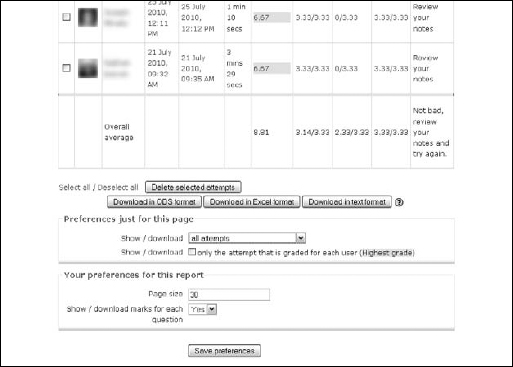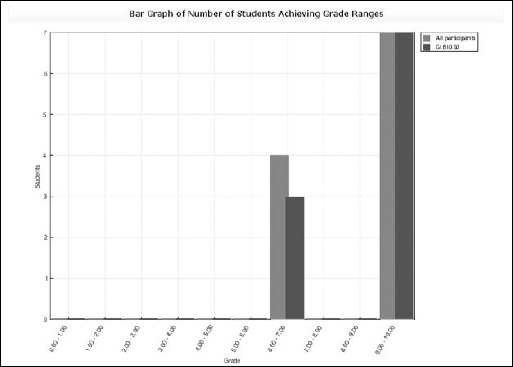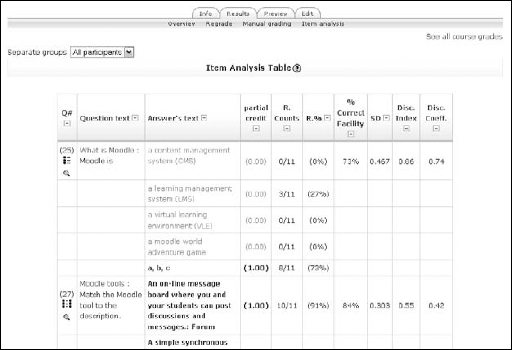Managing Quizzes and Data
Moodle collects data on all learners' activities, which is discussed in Chapter 14. Within the Quiz module, data is collected on individual learners, including results for individual responses and itemized analysis for each question.
Viewing the results
On the Editing Quiz page (refer to Figure 11-25), click the Results tab. This action opens the Overview quiz reports page, shown in Figure 11-26. There are four links right under the tabs: Overview, Regrade, Manual Grading, and Item Analysis.
Figure 11-26: Looking at the Results tab.

- Overview page: This page displays detailed information about learners' attempts, including dates when the quiz was taken and completed, time taken, overall score, score per question, and the feedback. If more than one attempt is allowed, you see the follow-up attempt(s) under the learner's name. The check box to the left of each attempt allows you to delete it. Note: If you want to add questions to the quiz, you need to delete all the attempts before Moodle allows you to make any changes.
At the bottom of the list, Moodle provides the overall average score as well as Select All and Deselect All links, which select all the attempts on the quiz or deselect the selections. (See Figure 11-27.) To remove the attempts whether they're all selected or just individual selections, click the Delete Selected Attempts button.
- • Downloading data: Moodle provides you with tools to download the data into industry standard formats. Located right under the Delete Selected Attempts button, you can click a button to download the data in ODS format, Excel format, or text format. Just click the appropriate button and follow the simple instructions.
- • Preferences for the page and the report: Moodle default setting displays information about all attempts on the quiz. The drop-down list below the download buttons lets you select All Attempts, which includes students in the current class and all past students who attempted the quiz who are no longer enrolled. The All Students option selects everyone whether or not they attempted the quiz. The other two options — Students with Attempts Only and Students with No Attempts Only — are self-explanatory. Below the drop-down list is a check box further allowing you to show or download only the attempts that are graded for each user for the highest grade.
Figure 11-27: Selecting and deselecting attempts.

You can also select how many students you want to be displayed on each page and if you want to show or download marks for each question — the default is Yes. Click the Save Preferences button.
Below the Save Preferences button, Moodle shows you a graphical display of a number of students achieving grade ranges, as shown in Figure 11-28.
- Regrade page: This link takes you to a report listing all quiz answers that you've altered when you were regarding. Moodle recalculates the grade only if you change the point value for a question or a quiz. Selecting the Regrade tab automatically starts the regrade process. Please note that this tab triggers the process and highlights those student answers that have been changed through the regrading process.
- Manual Grading page: This link is for manually grading questions that cannot be marked by Moodle, such as the essay questions, and for manually overriding and adding comments. For instance, you may find learners answer a specific short-answer question correctly, though Moodle marks it wrong. You can manually change the grade until the quiz is closed. I would then suggest that you add the acceptable answers to the question or alter the question.
- Item Analysis page: This tool is fabulous for evaluating the repeatability of the questions in the quiz. Moodle displays this report in a table, as shown in Figure 11-29. The basic info you want to see is comparing how the highest scores from students compared with the lowest on individual questions. Table 11-4 explains the table headings and how you can use them for your analysis.
Figure 11-28: Student grade ranges.

Figure 11-29: The Item Analysis Table.

Table 11-4 Understanding the Item Analysis Table
| Column Name | Description |
| Q | Displays question ID number, icon depicting type of question and a preview icon allowing a pop-up to appear with the questions |
| Question Text | The questions |
| Answerer's Text | Individual learners' answers |
| Partial Credit | Score for each answer |
| R. Counts | How learners selected a particular answer an the total number of attempts |
| R. % | Percentage of learners who selected the particular answer |
| % Correct Facility | Percentage of correct answers for a particular question. |
| SD | Standard deviation; measures the variation of selected answers |
| Disc. Index | Discrimination index |
| Disc. Coeff. | Discrimination Coefficient |
Below the table, you can choose a number of analysis options and use the three buttons to download the table in ODS format, Excel format, or text format.
Importing and exporting questions
If you have a repository of questions from various resources or use third-party software such as Blackboard or Hot Potatoes, Moodle has built-in tools and default formats enabling you to import questions and answers.
Often the method isn't straightforward with some of the software. It all depends on the database and on how it is set up. I found that it takes me longer to edit and check everything than using the Moodle interface and creating my questions. If you have hundreds of questions, I recommend experimenting; some good third-party tools can aid the process if you don't have success with the importing tools within Moodle.
You can also export your questions to a text file and make them available for reuse for other applications.
Links to Import and Export Questions pages are found on the Edit Quiz page, right under the tabs. (Refer to Figure 11-7.) Clicking these links takes you to the Import Questions From File page, from which you choose formats and make selections such as the category you want to import questions to or from, file format, and nearest grade. You can find more detailed explanation on the companion Webs site as well as links to resources on the Web.
![]() Moodle supports a popular quiz format called Hot Potatoes and TexToys quizzes. Teachers create the quizzes on their computers and then upload them to their Moodle courses. The Hot Potatoes module called hotpot module plugin is hidden within Moodle by default until you or your system administrator turns it on. If you have an administrative user account, go to the site front page Administration Block. From the subcategories, click Modules, and then click Activities. Enable the plugin by selecting the eye icon hide/show column. You can find more information about administrating Moodle in Chapter 13.
Moodle supports a popular quiz format called Hot Potatoes and TexToys quizzes. Teachers create the quizzes on their computers and then upload them to their Moodle courses. The Hot Potatoes module called hotpot module plugin is hidden within Moodle by default until you or your system administrator turns it on. If you have an administrative user account, go to the site front page Administration Block. From the subcategories, click Modules, and then click Activities. Enable the plugin by selecting the eye icon hide/show column. You can find more information about administrating Moodle in Chapter 13.
